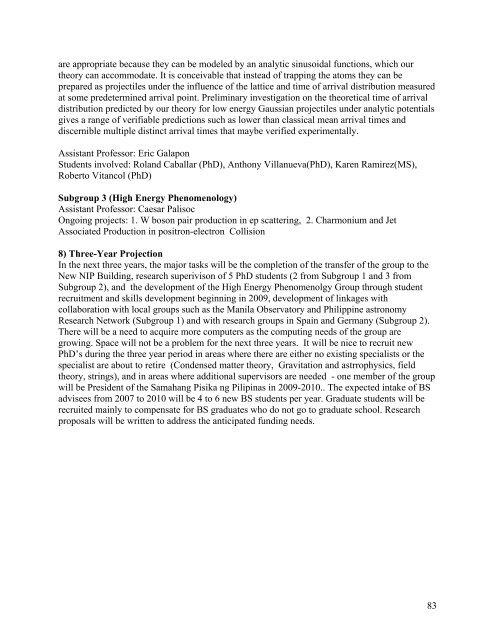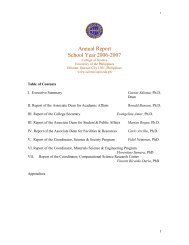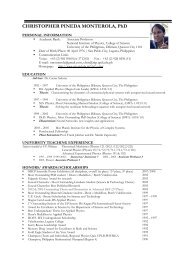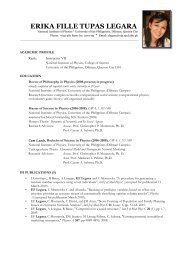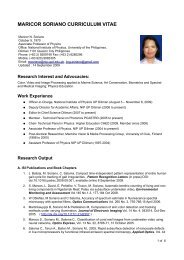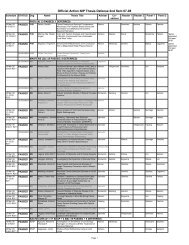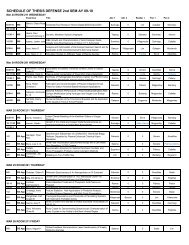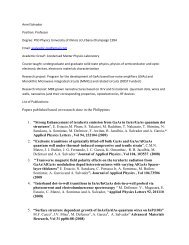NIP REPORT January 2006- May 2007 - The UP College of Science ...
NIP REPORT January 2006- May 2007 - The UP College of Science ...
NIP REPORT January 2006- May 2007 - The UP College of Science ...
You also want an ePaper? Increase the reach of your titles
YUMPU automatically turns print PDFs into web optimized ePapers that Google loves.
are appropriate because they can be modeled by an analytic sinusoidal functions, which our<br />
theory can accommodate. It is conceivable that instead <strong>of</strong> trapping the atoms they can be<br />
prepared as projectiles under the influence <strong>of</strong> the lattice and time <strong>of</strong> arrival distribution measured<br />
at some predetermined arrival point. Preliminary investigation on the theoretical time <strong>of</strong> arrival<br />
distribution predicted by our theory for low energy Gaussian projectiles under analytic potentials<br />
gives a range <strong>of</strong> verifiable predictions such as lower than classical mean arrival times and<br />
discernible multiple distinct arrival times that maybe verified experimentally.<br />
Assistant Pr<strong>of</strong>essor: Eric Galapon<br />
Students involved: Roland Caballar (PhD), Anthony Villanueva(PhD), Karen Ramirez(MS),<br />
Roberto Vitancol (PhD)<br />
Subgroup 3 (High Energy Phenomenology)<br />
Assistant Pr<strong>of</strong>essor: Caesar Palisoc<br />
Ongoing projects: 1. W boson pair production in ep scattering, 2. Charmonium and Jet<br />
Associated Production in positron-electron Collision<br />
8) Three-Year Projection<br />
In the next three years, the major tasks will be the completion <strong>of</strong> the transfer <strong>of</strong> the group to the<br />
New <strong>NIP</strong> Building, research superivison <strong>of</strong> 5 PhD students (2 from Subgroup 1 and 3 from<br />
Subgroup 2), and the development <strong>of</strong> the High Energy Phenomenolgy Group through student<br />
recruitment and skills development beginning in 2009, development <strong>of</strong> linkages with<br />
collaboration with local groups such as the Manila Observatory and Philippine astronomy<br />
Research Network (Subgroup 1) and with research groups in Spain and Germany (Subgroup 2).<br />
<strong>The</strong>re will be a need to acquire more computers as the computing needs <strong>of</strong> the group are<br />
growing. Space will not be a problem for the next three years. It will be nice to recruit new<br />
PhD’s during the three year period in areas where there are either no existing specialists or the<br />
specialist are about to retire (Condensed matter theory, Gravitation and astrrophysics, field<br />
theory, strings), and in areas where additional supervisors are needed - one member <strong>of</strong> the group<br />
will be President <strong>of</strong> the Samahang Pisika ng Pilipinas in 2009-2010.. <strong>The</strong> expected intake <strong>of</strong> BS<br />
advisees from <strong>2007</strong> to 2010 will be 4 to 6 new BS students per year. Graduate students will be<br />
recruited mainly to compensate for BS graduates who do not go to graduate school. Research<br />
proposals will be written to address the anticipated funding needs.<br />
83


